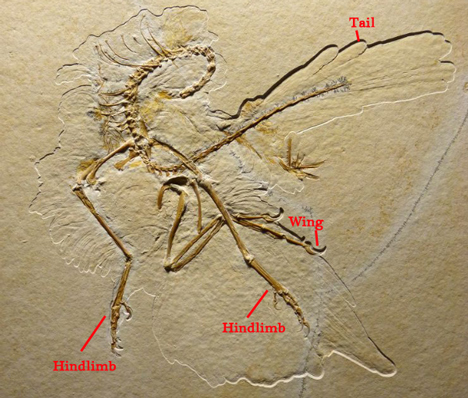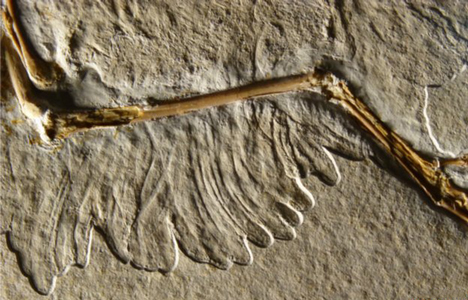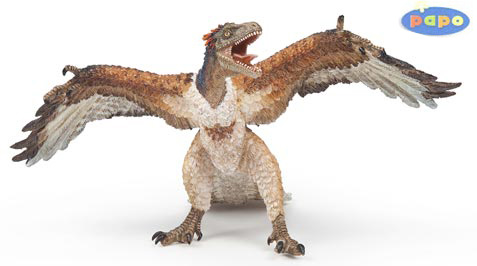New Research Suggests Feathers Evolved Before Flight? Archaeopteryx had Feathered Trousers
Archaeopteryx Fossil Suggests Origins of Flight Complex
Adorning the front cover of the latest edition of the academic publication “Nature” is a beautiful colour photograph of the eleventh specimen of Archaeopteryx found. The fossil might be in the hands of a private collector, but here is an example of wonderful co-operation between an individual and an academic institution. For permission has been granted for this fossil, discovered in southern Germany in 2011, to be extensively researched and the first studies into this remarkable fossil have just been published. We have a car manufacturer too, to thank for this research.
The Eleventh Archaeopteryx Specimen
Picture credit: Helmut Tischlinger
The Archaeopteryx Specimen
The picture above shows the Archaeopteryx fossil that has been the subject of this research. Although, like the majority of Archaeopteryx specimens the fossil has been crushed, the impressions of feathers on the wings, the tail and most significantly on the hind limbs can be clearly made out. Everything Dinosaur has added labels to help readers to understand what this fossil shows.
The plumage is extremely well preserved and even under normal light, impressions of feathers can be clearly made out. This has permitted a research team from the Ludwig Maximilian University of Munich (LMU) to study the feathers of this iconic creature and to compare them with feathered dinosaurs and bird fossils from China.
Palaeontologist Dr Oliver Rauhut of the Dept. of Earth and Environmental Sciences (LMU) and at the Bavarian State Collection for Palaeontology and Geology (Munich) and a co-author of the study commented:
“For the first time, it has become possible to examine the detailed structure of the feathers on the body, the tail and, above all, on the legs.”
Feathers Evolved Before Flight
Previous studies of this transitional fossil showed that Archaeopteryx possessed pennaceous feathers, the same sort of feathers associated with extant birds that can fly. The feathers were asymmetrical and helped maintain an aerodynamic shape in the air of this “dino-bird”. The presence of such pennaceous feathers on the hind legs had puzzled scientists.
Flight feathers on the hind limbs had led some palaeontologists to consider whether Archaeopteryx used its back legs in flight, it was, in effect, a four-winged glider. Or did the feathers on the hind limbs serve another purpose, perhaps for display or for insulation, helping to keep this warm-blooded (very likely), little theropod warm.
Specimen number eleven shows for the first time an imprint of virtually all of the plumage of Archaeopteryx including the tail feathers that measure up to 11.4 centimetres in length and those controversial feathers on the hind limbs that range in length from 4 to 4.5 centimetres. Analysis of the feathers on the hind legs show that they were symmetrical on either side of the stem (rachis), unlike aerodynamic feathers that have one long side and one narrower side (like an asymmetrical aircraft’s wing). It seems that the feathers on the hind limbs described as “feathered trousers” did not have a role in flight.
“Feathered Trousers”
This finding contradicts the theory that the flapping flight of modern Aves was preceded by an intermediary stage involving four-winged gliding.
A Close up of the Feathers on the Hind Leg
Picture credit: Helmut Tischlinger
The tail feathers, which were more than half the length of the caudal vertebrae (tail bones), were asymmetrical indicating that the tail could have been involved in flight, perhaps helping to provide lift and control. Co-author of the study Dr Christian Foth (LMU) along with Dr Rauhut and photographer Helmut Tischlinger examined a number of feathered bird and dinosaur fossils.
They discovered that these specimens showed a great deal of variation in feathers. Many of the feathered creatures in the study would have been incapable of flight as their arms were too short, other fossils had feathers in impractical places to permit a flight function.
The research team outline a new hypothesis that after feathers evolved, they became adapted for a range of different purposes, for display, for camouflage, to help keep animals warm and when the Dinosauria et al began to take to a more arboreal or aerial existence they evolved further to become more useful in flight and more aerodynamic in their shape. This theory suggests that there was not one single origin of bird flight, but that it may have evolved in a number of species over a significant time period – an example of convergent evolution.
A Model of an Archaeopteryx (Papo Archaeopteryx)
Picture credit: Everything Dinosaur
The Papo Archaeopteryx
The Papo Archaeopteryx model introduced in 2014, depicts Archaeopteryx with “feathered trousers”. The feathers although unlikely to have a role in powered flight, may have helped keep the legs warm or offered protection from bites from any of the prey of this carnivorous creature. Perhaps these feathers acted like air brakes helping to increase wind resistance as the animal came into land, thus slowing Archaeopteryx down and assisting with landing.
To view the range of Papo prehistoric animal figures: Papo Prehistoric Animal Models.
The German based researchers conclude that their study of the pennaceous feathers on Archaeopteryx, advanced maniraptoran dinosaurs and primitive birds indicates that these structures evolved in a functional context and not specifically for flight. Such feathers were slowly adapted for a role in the flight function, several lineages may have followed similar evolutionary developments leading to the aerodynamic, asymmetrical flight feathers occurring in a number of species. If this is the case, then the origin of powered flight might be a whole lot more complex than previously thought.
We have the German car manufacturer Volkswagen to thank for this research. The detailed analysis of the fossil was made possible by financial support from the Volkswagen Foundation.
A spokes person from Everything Dinosaur commented:
“The few fossils we have of Archaeopteryx may even represent sub-species or separate species. We could imagine a scenario whereby on the relatively isolated islands of the Solnhofen archipelago, different types of feathered, Archaeopteryx evolved. They may have once shared a common, mainland ancestor, but as populations became separated onto different islands, these weak-flyers evolved specific forms for each island habitat, a sort of Darwin’s finches as found on the Galapagos today but in this case, evolutionary dynamics driven by flight capabilities and not beak shape or size related to food resources.”




